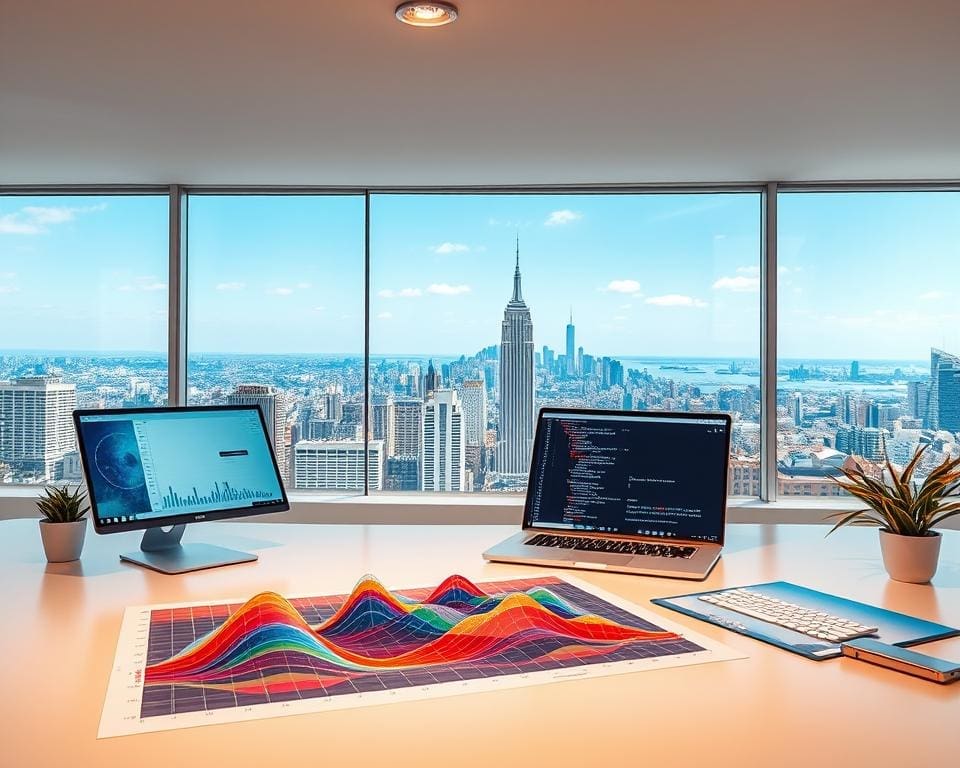In today’s data-driven world, understanding what Python libraries help with visual analytics is essential for professionals across various sectors. Python visual analytics libraries play a pivotal role in transforming complex datasets into meaningful and easily interpretable insights. These insights are crucial for effective decision-making in fields such as business, healthcare, and research. This article will explore some of the best Python libraries for data visualisation, highlighting their unique features and importance in delivering compelling visual narratives.
Introduction to Visual Analytics and Its Importance
Visual analytics stands at the intersection of data analysis and visual representation, offering a compelling approach for organisations to uncover insights from their data. By transforming complex numerical information into accessible visuals, users can swiftly identify trends, patterns, and anomalies within large data sets.
In today’s data-driven environments, the significance of visual analytics cannot be overstated. Businesses leverage Python visual analytics libraries to enhance their decision-making processes. For instance, these tools facilitate predictive analytics, enabling companies to anticipate customer behaviour and market trends effectively. Furthermore, visual analytics plays a crucial role in business intelligence, allowing teams to analyse performance metrics dynamically.
Moreover, in the realm of research analysis, visualisation not only aids in presenting findings but fosters a deeper understanding of complex datasets. The utilisation of data visualization libraries in Python empowers analysts and decision-makers to explore data interactively, ensuring that insights are not just derived but comprehended at a glance.

What Python libraries help with visual analytics?
Data visualisation is essential for transforming complex datasets into meaningful insights. By utilising Python libraries for visual analytics, analysts can create a range of static and interactive graphics that simplify data interpretation. These libraries cater to varying needs, making it easier for individuals and organisations to communicate their findings effectively.
Overview of Visual Analytics Libraries
Among the popular Python visualization tools are Matplotlib, Seaborn, and Plotly. Matplotlib serves as the foundation for data visualisation in Python, offering robust functionality for creating an array of static plots. Seaborn builds on this foundation by providing high-level interfaces for attractive statistical graphics, making complex visualisations straightforward. Plotly, known for its interactive capabilities, enables users to create engaging web-based visualisations. Each of these libraries provides unique features that enhance the visualisation experience, supporting various data-driven scenarios.
Why Choose Python for Visual Analytics?
Python stands out as a premier choice for visual analytics due to its simplicity and versatility. The extensive community support ensures that users have access to a wealth of resources, libraries, and documentation. This rich ecosystem significantly accelerates development processes, allowing analysts to focus on visual storytelling rather than technical challenges. Furthermore, Python’s compatibility with other data science tools enhances its utility in complex projects. By leveraging the strengths of Python libraries for visual analytics, individuals can unlock new dimensions in their data-driven decisions.
Top Python Libraries for Data Visualisation
In the realm of data visualisation, selecting the right tools can significantly enhance the clarity and impact of your insights. Two of the best Python libraries for data visualisation, Matplotlib and Seaborn, have risen to prominence among analysts and data scientists for their unique capabilities. This section delves into each library, showcasing their strengths in crafting compelling visual narratives.
Matplotlib: The Foundation of Data Visualisation
Matplotlib serves as the bedrock for data visualisation in Python. It offers an extensive array of plotting options, allowing users to create static, animated, and interactive graphics. Its flexibility is unparalleled, enabling customisation of nearly every aspect of a visualisation. Users can design fine-tuned representations of their data, ranging from simple plots to complex figures, making it one of the essential Python data visualization packages.
Seaborn: Statistical Data Visualisation Made Easy
Built atop Matplotlib, Seaborn takes a more user-friendly approach to statistical data visualisation. This library simplifies the process of creating aesthetically pleasing graphs while handling complex data representations. Seaborn’s default aesthetics offer a polished appearance, attracting users who appreciate elegance without sacrificing functionality. By providing succinct functions for intricate visualisations, it reinforces its status as a vital tool in the toolkit of anyone interested in the best Python libraries for data visualization.
Essential Python Visualization Tools for Analysts
Data analysts continuously seek efficient methods to convey complex information through visual means. Python offers a wealth of powerful visualisation tools, enabling analysts to refine their storytelling with data. Among these, Pandas stands out for its robust data manipulation capabilities, allowing users to organise and prepare data seamlessly.
Another essential tool is Plotly, which excels in creating interactive plots that captivate audiences. Its ability to implement dynamic elements encourages exploration and enhances user engagement. In addition, Altair presents a declarative approach to visualisation, enabling analysts to generate insightful graphics with clarity and simplicity.
These Python visualization tools converge to create a fluid workflow for data analysts. By leveraging their unique strengths, analysts can reveal compelling insights and produce visually appealing outputs. The integration of these resources illustrates the extensive capabilities offered by Python charting libraries, establishing an effective environment for elevating data analysis.
Data Visualisation Libraries in Python: A Comparative Analysis
Understanding the strengths and weaknesses of various Python visualisation libraries can aid users in making informed decisions tailored to their specific needs. Each library presents unique features that cater to different levels of expertise and project requirements. Below is a comparative overview of popular options in the realm of Python charting libraries and visualisation libraries.
Pros and Cons of Popular Libraries
- Matplotlib:
- Pros: Highly customisable and versatile, supports 2D plotting, well-documented.
- Cons: Complicated for beginners, not as aesthetically pleasing out of the box.
- Seaborn:
- Pros: Simplifies statistical plotting, beautiful default styles, built on Matplotlib.
- Cons: Limited interactivity, occasionally complex for customised plots.
- Plotly:
- Pros: Interactive charts, great for web applications, supports a variety of chart types.
- Cons: Can be resource-heavy, sometimes requires licensing for advanced features.
- Bokeh:
- Pros: Excellent for building interactive visualisations for web browsers, supports large datasets.
- Cons: Steeper learning curve compared to some libraries, not as concise for simple plots.
Python Charting Libraries Worth Exploring
In the realm of data visualisation, the selection of the right tool can significantly influence the insights gleaned from data. Among the lesser-known yet powerful Python graphing libraries, several charting frameworks can elevate your visualisations. Altair stands out for its declarative syntax, which allows for the straightforward creation of complex statistical charts.
Another notable library, ggplot, brings the grammar of graphics approach to Python. This familiar style enhances user experience for those transitioning from R. Developers will appreciate how ggplot makes it easier to construct multidimensional visualisations by layering components individually.
Pygal offers a unique benefit by generating SVG charts that are lightweight and scalable. This feature is especially useful for web applications, as it ensures crisp visuals regardless of screen size. Each of these Python data visualization packages provides innovative solutions for specific visualisation challenges, proving that versatility in data analysis is entirely possible.
Interactive Visualisations with Python
In an era where data is paramount, the ability to create interactive visualisations with Python stands out as a vital skill for analysts and developers. Engaging visual representations not only elucidate complex datasets but also foster an enriched user experience. Two of the leading tools in this domain are Plotly and Bokeh, which are renowned for their capabilities in crafting dynamic and visually appealing displays.
Plotly: Bringing Data to Life
Plotly excels in producing interactive plots that can be seamlessly embedded into web applications. Its user-friendly interface allows users to create elaborate charts, graphs, and dashboards that respond to user inputs, making data storytelling engaging. Users can easily connect Plotly with various data sources, enhancing its utility across multiple sectors such as finance, healthcare, and education. The versatility of Plotly renders it among the best Python libraries for data visualization, allowing for the crafting of tailored visual solutions.
Bokeh: Excellent for Dynamic Visuals
Bokeh shines in its ability to handle large datasets, transforming them into dynamic visualisations that can captivate audiences. Its capability to create browser-based applications allows users to interact with the data directly, facilitating real-time updates and modifications. This functionality makes Bokeh particularly advantageous for projects requiring intricate detail and high interactivity. By harnessing the features of Bokeh, data scientists and analysts can significantly enhance their visual storytelling prowess.
Exploring Python Data Visualisation Packages
Python offers a diverse range of data visualisation packages that can significantly enhance the process of creating compelling and insightful visual representations of data. Among these, two standout Python visual analytics libraries are Altair and Dash, each bringing unique strengths and capabilities to the table.
Altair: Declarative Statistical Visualisation
Altair is designed with a declarative approach in mind, allowing analysts to effortlessly craft statistical visualisations. The library provides a concise syntax that facilitates the creation of complex graphics while maintaining clarity and simplicity. This focus on declarative visualisation empowers users to concentrate on the data representation instead of navigating intricate coding syntax. As a result, Altair efficiently transforms data into stunning visual narratives, making it an invaluable tool among Python data visualization packages.
Dash: Building Web Applications for Data Science
Dash stands out as a powerful tool for those looking to integrate Python data visualisation with web applications. It enables users to develop interactive and informative dashboards that can be shared and deployed effortlessly. Built on Flask, Plotly, and React, Dash combines the strength of Python’s visual analytics libraries with web technologies, allowing analysts to create engaging applications that communicate insights effectively. This capability not only enhances collaboration but also expands the reach of data storytelling, revolutionising how teams interact with data.
Python Graphing Libraries for Complex Data Sets
The realm of data visualisation is evolving, particularly when dealing with complex data sets that challenge the limits of conventional approaches. Python graphing libraries provide a powerful suite of tools specifically designed for advanced analytical tasks. Among the top Python libraries for visual analytics, NetworkX emerges as a standout, enabling users to create, manipulate, and study intricate network structures with ease. This specialised library is ideal for applications in social network analysis, biological network exploration, and the visualisation of dynamic systems.
In addition to NetworkX, other Python graphing libraries excel in managing multi-dimensional data. For example, libraries such as Plotly integrate graphing with interactivity, allowing analysts to delve deeper into their data while retaining clarity in representation. These tools demonstrate the capability of Python to handle complex data visualisations that not only inform but also inspire innovative decision-making within various domains.
The significance of using these Python graphing libraries cannot be overstated. They extend the potential for insight beyond the ordinary, catering to niche areas where typical visualisation methods may falter. As data continues to grow in complexity, leveraging the specific features of Python’s graphing libraries becomes essential for analysts aiming to uncover hidden patterns and relationships within their data.









